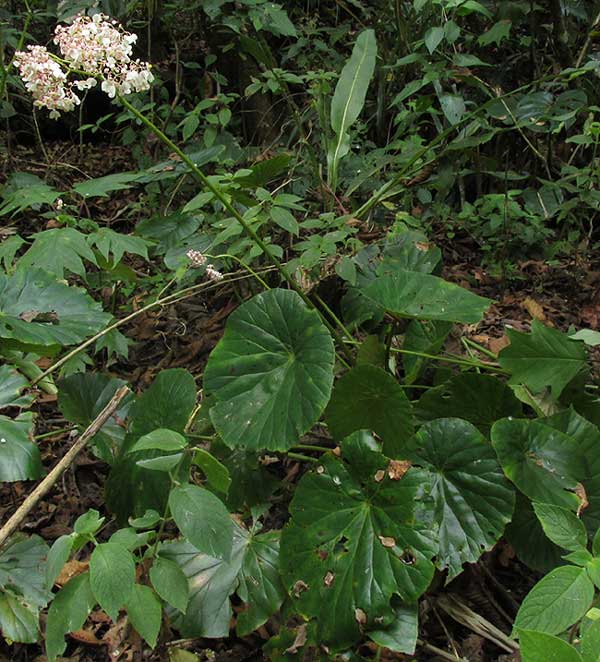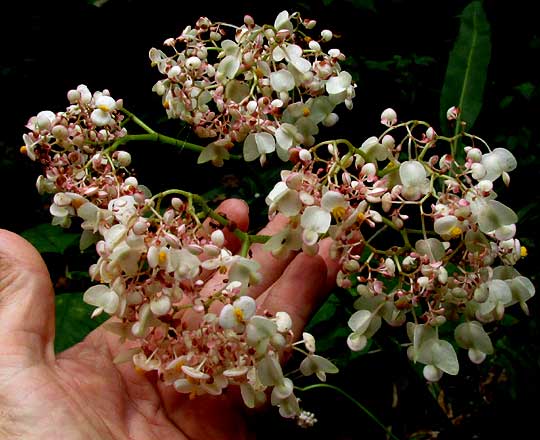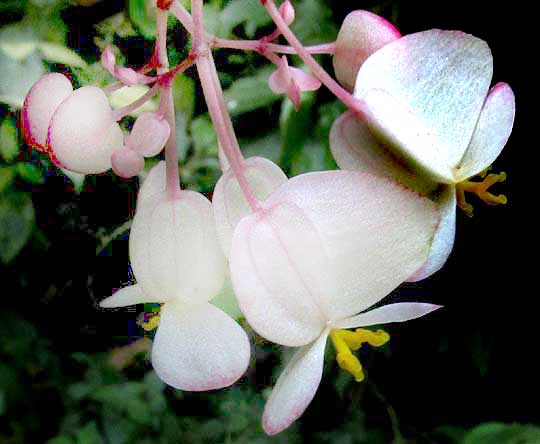Excerpts from Jim Conrad's
Naturalist Newsletter

notes from the May 3, 2015 Newsletter describing a camping trip in the hydrological reserve above San Andrés Tuxtla, Veracruz, México (elevation ~1180m (5900ft), ~N18.52°, ~W95.15°)
LOTUS-LEAFED BEGONIA
Right beside the epiphytic Strap Fern, in full blossom, there was a wildflower of a kind never found in temperate forests, shown above.
Anyone who deals much with the North's potted house plants will recognize this as a begonia, though one much larger than those normally found in pots. This one grew about waist high. A close-up of the plant's flowering head is shown below:

Closer still, below you can see some typical begonia flowers:

Begonias are "monoecious," meaning that separate male and female flowers are produced on the same plant. Those in the picture are female flowers, on which the fingerlike yellow things are styles bearing twisted stigmas. The two white, petal-like things below the styles are indeed the flower's two petals, and below the petals (above them in the picture) the broad, papery items are "wings" on the ovary. One visualizes the ovary maturing into a fruit with the dried wings helping in wind dispersal.
It can be a challenge to identify wild begonias to species level because the genus Begonia is a big one, with more than 1,600 recognized species. It's considered the sixth-largest genus of all angiosperms. Happily, the online Flora de Veracruz has its Begonia volume finished, so I could key out our pretty cloud-forest denizen.
With un-lobed, roundish leaves arising from a thick, short rhizome, or underground stem, attached to their petioles near the center of the blades' undersurfaces (the leaves are "peltate"), and with the plant's and flowers' large size, this Begonia keyed out fairly easily to BEGONIA NELUMBIIFOLIA. Long ago gardeners discovered the charm of this robust species, so it bears established English names, the most commonly appearing being Lotus-leafed Begonia and Water-lily Begonia, referencing the species name, Nelumbo being a water-lily genus.
Our Lotus-leafed Begonia occurs spottily in southern Mexico and south through Central America to Colombia. The waist-tall ones in the shadowy understory around my tent actually were small ones. Out on the road through the reserve where plants not only had plenty of moisture but also sunlight, they grew head tall, making them the biggest begonias I'd ever seen.
Folk medicine regards this begonia's leaves as good for treating bumps and bruises. Typically, you mash the semi-succulent leaves with a little water and apply the moist pulp to the injury, tying the pulp in place with a rag and changing the pulp three times a day.